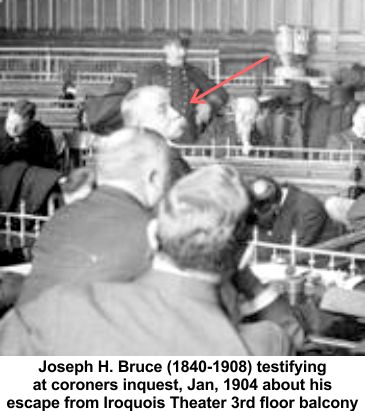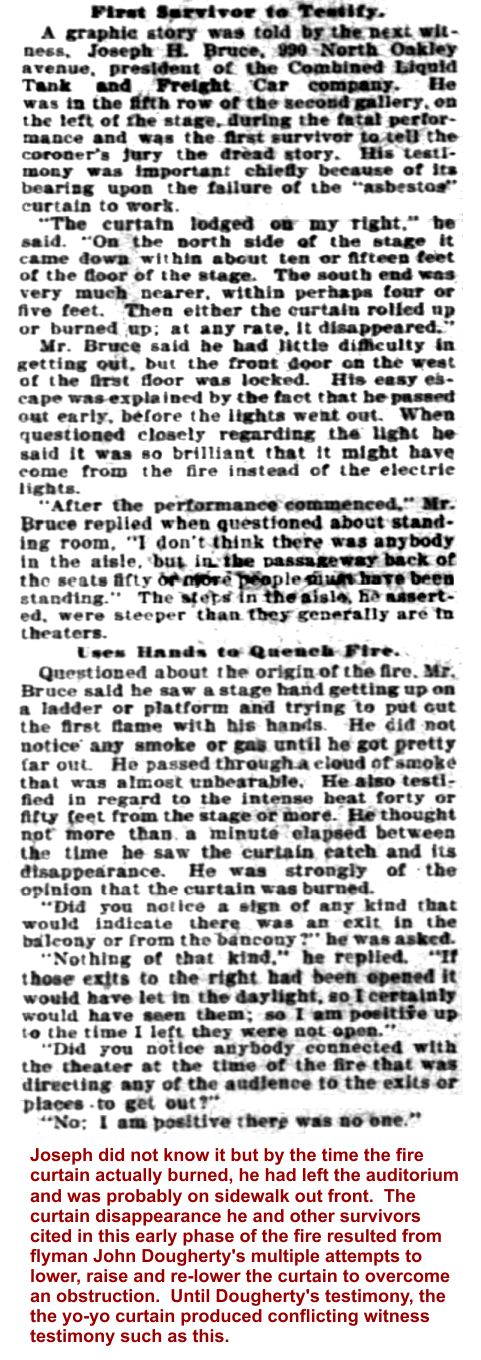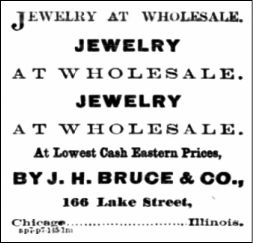|
Sixty-three-year-old Joseph H. Bruce (1840–1908)
of 990 North Oakley Avenue in Chicago survived the
Iroquois Theater fire in 1903 and was one of the first
to testify at the coroner's inquest in January 1904.
(See clipping at right.)
Based on reports of his testimony in two newspapers,
it seems likely he attended the Mr.
Bluebeard matinee
alone. He was not quoted in testimony at the
coroner's inquest as using the pronoun "we" that
would have indicated a companion, such as his wife,
Lizzie.

In the early years
A native of Massachusetts, Joseph was the oldest of
six children born to Maine natives, Joseph Atherton
Bruce Sr and Rozina Young Bruce. He grew up in
Charlestown and Somerville, Massachusetts.
He followed in his father's footsteps and worked in
the jewelry trade as a young man, employed in the
"jewelry capital of the world," Attleboro,
Massachusetts. At age twenty-two, he married
Elizabeth Barron Graves Bruce, and their daughter,
Iola Bruce (1867–1940), was born in Virginia five
years later.*
The pull of the west was strong for the Bruce
family. Joseph, Lizzie, and toddler Iola followed
his father, uncle, and brother — Joseph sr, Miner,
and Orin Bruce — from Massachusetts to Chicago in
1862, on to Omaha in 1870, and to Knox county
Nebraska in 1871. There they joined a handful of
other pioneers in founding the Bruce Colony about
200 miles northwest of Omaha, today a one and a half
to two-hour drive from larger cities. The colony
would be named after John Creighton, founder of
Omaha's Creighton University.
Snow, grasshoppers, and hunger
Creighton, Nebraska families, endured substantial
adversity in the early years. The first winter,
spent in sod houses, included a snowstorm that
lasted fifty days and left them isolated from
food-merchant traders. Some families were forced to
survive on flour — driven to $5 per sack ($110 with
inflation) by opportunistic fellow citizens.
(Remember the prairie mercenary of TV,
Mrs. Oleson on Little House on the Prairie?) In 1874 came a plague
of locusts that decimated crops, depleted food
supplies, and brought starvation the following
winter. (Read a sobering account of the
Year of the Locust.)
A period biographical sketch made note that Lizzie
was the second white woman to settle in Creighton,
reminding me of Willa Cather's classic, My
Antonia, set in a fictional Nebraska prairie town during the
same period. I don't know if today's Creighton,
Nebraska history buffs would concur with that
characterization.
Town emerges
Though the community's founder, Joseph Bruce Sr.,
did not live to see it happen, passing during the
summer of 1875, things got progressively better for
Creighton, Nebraska after that. Joseph and Lizzie
built a home in 1877, and Joseph operated a
furniture store. He served as postmaster and, in
1881, helped persuade the Sioux City & Pacific
Railroad to build a depot there in Creighton. By
1883 land sold for $5-10/acre, and farms were said
to have doubled in value over the prior year.
Left behind a thriving city
Creighton then could boast of having a restaurant
and a hotel, a dry goods store and a feed store, a
newspaper edited by the town barber, and a drugstore
operated by the town doctor. Stage lines ran between
Creighton and Yankton and O'Neill City.
I failed to find an explanation for Joseph and his
family leaving Creighton. He was ambitious, I
suspect, maybe needed a bigger pond, or may have
inherited his father's restless streak. Daughter
Iola was twenty-one, and husband prospects in
Creighton may have been limited. (She married in
Chicago eight years after their relocation.)
Whatever the reason, he had cause to feel proud of
his family's contribution to the Nebraska prairie.
When he left for Chicago around 1888, seventeen
years after the Bruce Colony was founded,
Creighton's population had grown to over 900.
Read more about the founding of Creighton.
|
 |
Joseph in the big city
In Chicago, Joseph sold real estate and operated a
publishing company for a time. In May 1903, he
founded a new company, incorporated in South Dakota,
The Combined Liquid Tank and Freight Car Company. He
aspired to become the next Pullman by building
railroad cars using a
patented system he invented to transport cattle.†
A corporate office was set up at 80 Dearborn St. in
Chicago, the stock was offered for $.15 per share,
and fifty acres were purchased in nearby Gary,
Indiana, on which to build a plant expected to
employ 500 to 2,000 workers.
Death brought an end to Joseph's dreams of railroad
wealth the summer of 1908. He was buried in the
Forest Home Cemetery in Forest Park, Illinois, near
Chicago.
You can read his obituary online.
Back in Nebraska, his mother died two months later.

Enlarge

In April, 1862 Joseph sold jewelry in Chicago before heading west to Omaha.
|
